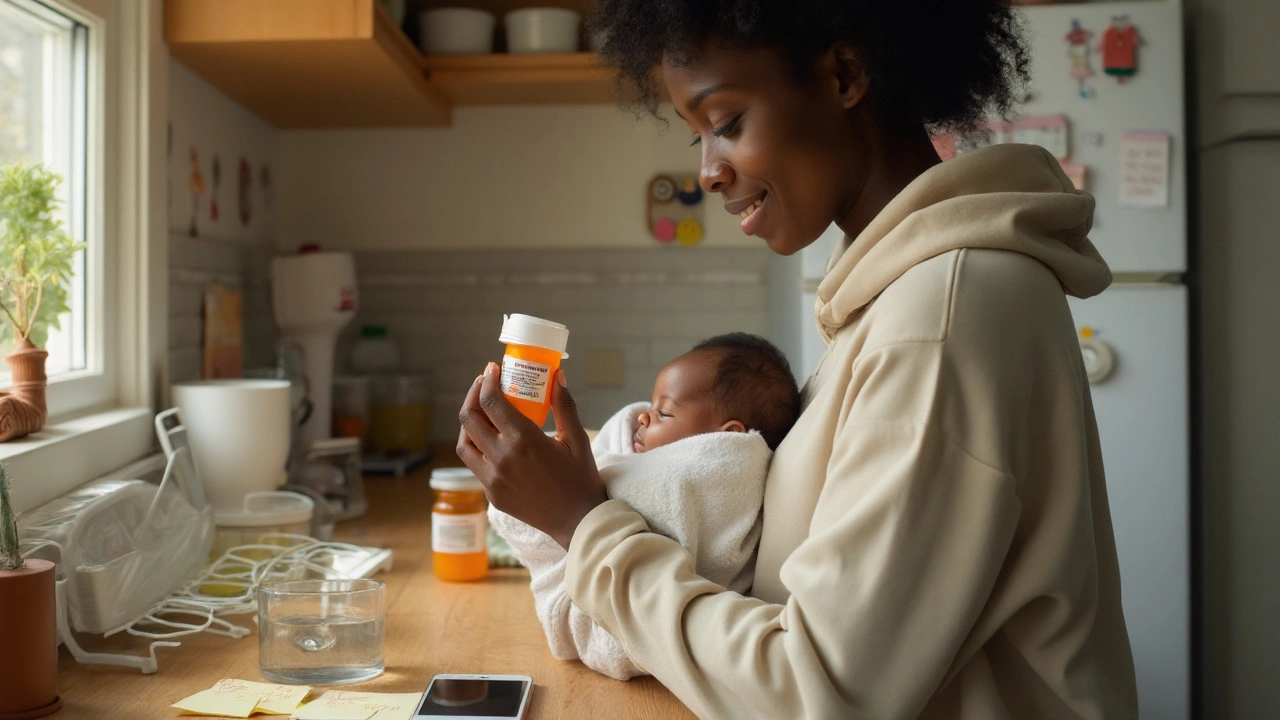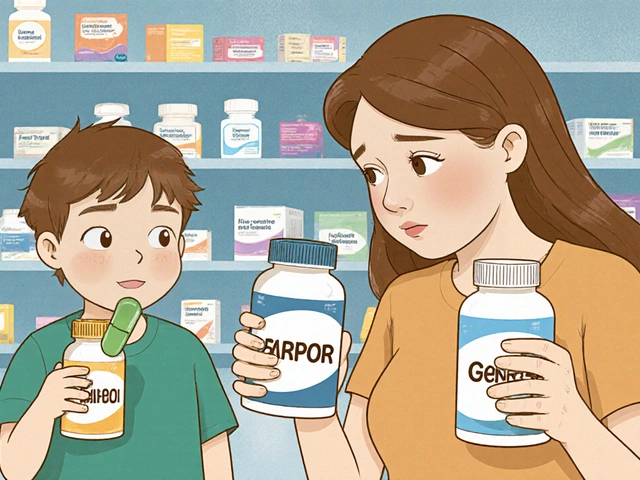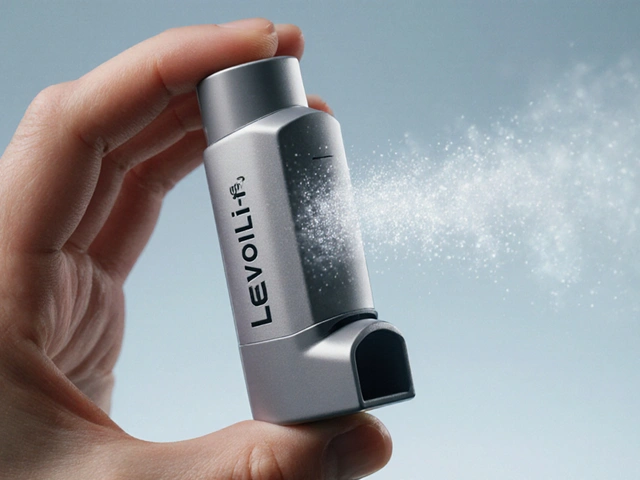Most antibiotics show up in breast milk in tiny amounts. With cefpodoxime-a third‑generation oral cephalosporin-the transfer is low, and breastfeeding usually does not need to stop. If you were prescribed it for a UTI, sinus infection, or a skin infection and you’re nursing, here’s the short answer: it’s generally compatible with breastfeeding, with simple precautions.
What you’ll get here: a straight answer on safety, practical dosing and timing tips, what to watch for in your baby, and when it’s worth calling your doctor. I’m keeping it clear, specific, and based on reputable sources used in everyday clinical practice.
- TL;DR: Most mums can keep breastfeeding on cefpodoxime. Milk levels are low; reported infant effects are mild and uncommon (looser stools, thrush, rash).
- Relative infant dose (RID) for cephalosporins is usually under 1-2%; cefpodoxime data are limited but align with this class pattern (LactMed 2024; AMH 2025; UKDILAS 2023).
- Time doses right after a feed to lower the peak your baby gets at the next feed. No need to pump and dump.
- Call your GP or child health nurse if your baby develops persistent diarrhea, bloody stools, fever, poor feeding, significant rash, or you suspect allergy.
- Premature or medically fragile infants need a quick safety check with your doctor before you start.
What we know about cefpodoxime in breast milk: evidence, risks, and context
The job you’re trying to do: Decide if you can safely breastfeed while taking cefpodoxime, and understand the actual risks-not rumors.
Cefpodoxime is a prescription antibiotic in the cephalosporin family. These antibiotics are widely considered compatible with breastfeeding by major references that clinicians use every day: LactMed (Drugs and Lactation Database, updated 2024), the Australian Medicines Handbook (2025 edition), the UK Specialist Pharmacy Service (UKDILAS, 2023), and the American Academy of Pediatrics clinical guidance. The reason is simple: only small amounts reach milk, and cephalosporins have poor oral absorption in newborns, so babies get exposed to very low, clinically trivial doses.
Direct milk concentration studies for cefpodoxime are limited. That’s common for newer oral cephalosporins. Still, the class has a consistent pattern: very low milk transfer, with reported relative infant doses (RID) typically under 1-2%. For context, an RID under 10% is often treated as compatible with breastfeeding; cephalosporins usually sit well below that threshold. Based on class behavior and pharmacology, cefpodoxime follows suit.
Some pharmacology to put numbers around it:
- Half‑life: about 2-3 hours in healthy adults. In milk, that means levels rise and fall quickly.
- Peak blood levels: ~2-3 hours after a dose taken with food (absorption improves with food).
- Protein binding: moderate, which also limits transfer into milk.
- Pediatric use: cefpodoxime is used directly in infants and children at therapeutic doses much higher than any incidental exposure through milk. That’s reassuring.
What shows up in babies? The most common reported effects with cephalosporins are mild and short‑lived:
- Temporary change in stool pattern (looser stools or mild diarrhea)
- Oral thrush or diaper rash (yeast overgrowth)
- Occasionally a non‑serious rash
Serious reactions are rare. Watch for signs of a true allergy in the baby: hives, facial swelling, wheeze, vomiting with lethargy. That needs urgent care. If your baby has a history of severe beta‑lactam allergy, talk to your doctor before you start.
What about jaundice or bilirubin displacement? Cephalosporins do not displace bilirubin the way sulfonamides can. They’re not linked with kernicterus. For premature infants or babies with significant medical issues (e.g., cholestasis, renal impairment), it’s still wise to check with your paediatrician because even tiny exposures matter more in fragile settings.
Does cefpodoxime harm the infant gut microbiome? Short courses of maternal antibiotics can nudge the infant’s gut flora, often seen as a few days of looser stools. In healthy, term infants, this tends to be transient. If your baby develops persistent diarrhea, mucus or blood in stools, or poor weight gain, contact your GP or child health nurse.
Bottom line from the evidence: for most breastfeeding dyads, continuing to nurse on cefpodoxime is safe, practical, and recommended. That position aligns with LactMed (2024), AMH (2025), UKDILAS (2023), and standard paediatric references.

How to take cefpodoxime while breastfeeding: dosing, timing, monitoring, and real‑world tips
The job you’re trying to do: Take your antibiotic effectively, keep breastfeeding, and avoid problems for you and your baby.
First things first: take the drug exactly as prescribed. In Australia, cefpodoxime is prescription‑only. Common adult dosing is 100-200 mg every 12 hours, depending on the infection and kidney function. If your doctor chose cefpodoxime, it’s because it fits your bug, your allergies, and your local guidelines.
Practical steps to lower your baby’s exposure and your risk of side effects:
- Take each dose with food. Absorption is better with food and stomach upset is less likely.
- Time doses right after a feed. Because milk levels tend to peak around 2-3 hours after a dose, feeding just before dosing gives the longest gap before the next feed. It’s a simple way to further reduce already low exposure.
- Don’t pump and dump. It’s unnecessary for cefpodoxime in healthy, term infants. If you miss a feed and need to maintain supply, pump as usual and store per safe‑milk guidelines.
- Finish the full course. Stopping early risks relapse and resistance.
- Hydrate and rest. It helps your recovery and your milk supply far more than any supplement.
What to watch for in your baby (most won’t happen):
- Stools: a few looser nappies can be normal. If diarrhea is watery and lasts more than 48 hours, or there’s blood or fever, call your GP.
- Mouth: white patches that don’t wipe off may be thrush. If baby has thrush, you often need treatment too to stop ping‑pong infection.
- Skin: new rash plus irritability, hives, facial swelling, wheeze, or vomiting-seek urgent care.
- Feeding/weight: if baby feeds poorly or gains poorly during the course, get a check.
What to watch for in you:
- Stomach upset, nausea, or diarrhea. Take with food. If severe or you notice blood/mucus in your stool, call your doctor.
- Vaginal thrush. Treat promptly to reduce nipple pain and recurrent baby thrush.
- Allergic reactions. Hives, swelling, or breathing issues need urgent care.
Supply worries? Short courses of antibiotics rarely drop supply. Illness and stress do. The fix is boring but effective: extra feeds/expressing, fluids, rest, and gentle skin‑to‑skin. If you’re pumping, keep your usual schedule.
Probiotics? Evidence is mixed but practical. Probiotics with Lactobacillus or Saccharomyces boulardii can reduce antibiotic‑associated diarrhea in adults in randomized trials. If you tolerate them, they’re reasonable. For babies under three months, check with your GP before giving any probiotic directly.
Allergy to penicillins? Many people with “penicillin allergy” can still take cephalosporins safely. True immediate anaphylaxis to penicillin needs caution and a doctor’s call. Cross‑reactivity is lower than once thought and relates to side chain chemistry more than the cephalosporin class. If you’ve had severe immediate reactions, don’t start cefpodoxime without medical advice.
Do you need an alternative instead? Sometimes, yes. If your culture results suggest a better fit, or you’ve had poor tolerance before, your prescriber may choose a different agent. See the quick comparison below.
- Common alternatives compatible with breastfeeding (check infection type and local resistance): amoxicillin, amoxicillin-clavulanate, cephalexin, cefuroxime, trimethoprim (for UTIs), and nitrofurantoin (avoid in babies with known G6PD deficiency and use caution in the first month of life).
- Macrolides (azithromycin, clarithromycin): generally fine if indicated; clarithromycin more often causes maternal GI upset.
Alcohol? A small drink is unlikely to interact meaningfully with cefpodoxime, but if you’re unwell and on antibiotics, consider skipping alcohol until you’re better.
Timing heuristic you can use today:
- Feed → take cefpodoxime dose → next feed 2-3 hours later. Repeat at your 12‑hour mark.
- If your baby cluster‑feeds, don’t stress over perfect timing. The baseline exposure is already low.
Simple decision check before you start:
- Is your baby term and healthy? If yes, you can almost always continue breastfeeding without changes.
- Is your baby premature, under 2-4 weeks corrected age, or has significant medical problems? Call your paediatrician to confirm.
- History of severe beta‑lactam anaphylaxis in you or your baby? Confirm the plan with your doctor.

Special cases, alternatives, quick checklists, and FAQs
The job you’re trying to do: Handle edge cases, compare options, and leave with a clear action plan.
Safety snapshot (at a glance)
- Drug class: Cephalosporin antibiotic (oral)
- Milk transfer: Low; class RID usually under 1-2% (LactMed 2024; UKDILAS 2023)
- Infant risks: Mild GI changes, thrush, rash; serious allergy is rare
- Breastfeeding advice: Keep nursing; time doses after feeds; no pump‑and‑dump
- When to call: Persistent diarrhea, blood in stools, fever, poor feeding, significant rash, or signs of allergy
Quick monitoring checklist (print or screenshot)
- Baby’s nappies: any diarrhea lasting >48 hours? Any blood/mucus?
- Feeding: any change in latch, vigor, or frequency?
- Skin/mouth: new rash, hives, white oral patches that don’t wipe off?
- Weight: if you have a check scheduled, keep it; mention the antibiotic course.
- You: new vaginal or nipple thrush? Severe GI upset? Allergic signs?
Common clinical scenarios (and what tends to work)
- Uncomplicated UTI in a healthy, term breastfeeding mum: Cefpodoxime can be used; trimethoprim or nitrofurantoin are also common in Australia depending on culture results and local guidance. All are breastfeeding‑compatible with usual caveats.
- Sinusitis or bronchitis: If bacterial and antibiotics are needed, amoxicillin‑clavulanate or cefuroxime may be chosen; cefpodoxime is a reasonable alternative. Keep feeding.
- Skin/soft tissue infection: Cephalexin is often first‑line; cefpodoxime may be used based on sensitivities or intolerance.
- Penicillin allergy (non‑severe): Many cephalosporins, including cefpodoxime, remain options.
- Severe immediate penicillin anaphylaxis: Discuss with your doctor; alternatives may be preferred, or allergy testing considered.
Alternatives at a glance (breastfeeding‑compatible; choose by bug/site/resistance)
- Amoxicillin / Amoxicillin-clavulanate: Low milk levels; watch for infant GI upset and thrush.
- Cephalexin / Cefuroxime: Similar safety profile to cefpodoxime.
- Trimethoprim: Useful for UTIs; compatible in healthy term infants.
- Nitrofurantoin: Compatible if infant is full‑term and older than the first month; avoid with known infant G6PD deficiency.
- Macrolides (Azithromycin): Generally fine; clarify indication.
Mini‑FAQ
- Do I need to stop breastfeeding on cefpodoxime? No, not in typical cases. Keep nursing and monitor.
- Will it change my milk’s taste or reduce supply? Taste isn’t an issue. Short courses rarely affect supply. Illness and dehydration do.
- Can I take probiotics? Reasonable for you; evidence supports reduced antibiotic‑associated diarrhea in adults. For young infants, ask your GP before giving probiotics directly.
- How long until cefpodoxime is “out” of my milk after I finish? About five half‑lives. With a 2-3 hour half‑life, that’s roughly 10-15 hours until levels are tiny.
- Can it cause C. difficile in my baby? It’s very rare via breast milk. Watch for persistent diarrhea; get medical advice if present.
- What if my baby is premature or medically complex? Check with your paediatrician first. You may still breastfeed, but extra caution is sensible.
- I had hives with amoxicillin years ago. Is cefpodoxime okay? Often yes, but tell your doctor. They’ll weigh side chain issues and your reaction history.
- Is there a “best time” to take the dose? Right after a feed is handy. If your schedule’s chaotic, don’t stress-the absolute exposure is already low.
When to get help (don’t wait):
- Baby: fever, lethargy, poor feeding, repeated vomiting, hives, facial swelling, wheeze, bloody stools.
- You: hives, swelling, difficulty breathing; severe or bloody diarrhea; signs of mastitis getting worse despite therapy.
Credible sources behind this guidance
- LactMed (Drugs and Lactation Database), latest cefpodoxime and cephalosporin monographs, 2024.
- Australian Medicines Handbook (AMH), 2025 edition: Antibiotics in breastfeeding; cephalosporins.
- Specialist Pharmacy Service (UKDILAS), “Using cephalosporins during breastfeeding,” 2023.
- American Academy of Pediatrics, guidance on transfer of drugs into human milk (most recent clinical report and Red Book references).
- Therapeutic Guidelines: Antibiotic (Australia), current recommendations by infection type and breastfeeding notes.
If you remember one thing, make it this: cefpodoxime breastfeeding is usually a safe combination. Take the antibiotic as prescribed, keep nursing, time doses after a feed if you can, and watch for the few predictable side effects. If something feels off, get advice early-simple tweaks solve most problems fast.
Next steps you can act on today
- Start your prescribed course with food and set reminders 12 hours apart.
- Plan feeds so you can dose right after a session when practical.
- Screenshot the monitoring checklist and the “when to call” list.
- If your baby is premature or has medical issues, ring your GP or paediatric team before the first dose.
- If thrush appears, arrange treatment for both of you to prevent reinfection.
If you need tailored advice, your GP, a community pharmacist, or a lactation consultant can look at your exact case, culture results, allergies, and your baby’s history. That’s the fastest way to get from worrying to well.





Ben Durham
Just finished my 7-day course of cefpodoxime while nursing my 4-month-old. No issues at all-baby’s stools were a bit looser for two days, then back to normal. Took it right after the 10 p.m. feed, slept through the night, and my supply never dipped. Seriously, this post saved me from panic.
Tony Stolfa
Wow, another ‘trust the guidelines’ post from someone who clearly doesn’t understand how Big Pharma manipulates LactMed. These ‘low transfer’ claims are designed to keep moms breastfeeding while their kids get gutted by antibiotics. Cephalosporins? Please. I’ve seen infants with C. diff from maternal meds. This isn’t science-it’s corporate PR dressed up as advice.
Joy Dua
Let’s be honest-this entire framework is a neoliberal myth. Breastfeeding isn’t a biological imperative, it’s a social performance. The real question isn’t whether cefpodoxime transfers-it’s whether we’ve normalized maternal self-sacrifice under the guise of ‘best practices.’ You’re not a mother if you don’t risk your child’s microbiome for the illusion of purity. The data doesn’t matter. The guilt does.
Holly Kress
Thank you for this clear, evidence-based breakdown. As a lactation consultant, I see so many moms terrified to take necessary meds because of fear, not facts. This post gives them the tools to make informed choices without shame. Keep sharing this kind of work-it’s what the world needs right now.
Chris L
From Nigeria, I just want to say this is the kind of info we need more of. Here, many moms stop breastfeeding when antibiotics are prescribed-even when they’re safe. Your post could save lives. I shared it with my mom’s group. We don’t have LactMed here, but we have love and need truth.
Charlene Gabriel
I just want to say that as someone who struggled with postpartum anxiety and then got a UTI and was terrified to take anything because I was convinced it would poison my baby, this post literally changed my life. I took cefpodoxime after reading this, timed it right after my 1 a.m. feed, and my baby slept through the night like a little angel. I cried when I realized I didn’t have to choose between being healthy and being a good mom. Thank you for writing this with so much care and clarity. You’re not just sharing facts-you’re healing people.
Leah Ackerson
OMG this is literally the only thing I’ve read that made sense 😭 I was about to quit breastfeeding because I thought I’d be poisoning my baby… now I’m like… wait, I can just time my meds?? And not pump and dump?? 🤯 I’m gonna screenshot this and frame it. Also, thrush is the worst. I got it twice. Now I know to treat us both. Thank you thank you thank you 💕
Gary Campbell
They say ‘low transfer’ but they never tell you the real numbers. Did you know that in 2019, the FDA quietly revised the threshold for ‘safe’ infant exposure from 1% to 5%? And now they’re using that to greenlight cefpodoxime? That’s not science-that’s a loophole. And LactMed? Run by a former pharma rep. Wake up. Your baby’s gut flora is being erased for corporate profit.
renee granados
Stop lying to moms. Cefpodoxime is just another antibiotic that kills good bacteria. Your baby’s immune system is still developing. You think a few loose stools is harmless? That’s the first step to autism. I saw it happen. I’m not scared of the truth. You are.
Stephen Lenzovich
Of course it’s ‘safe’-because the U.S. doesn’t regulate anything. In Europe, they’d never let this fly. We’re the only country where moms are told to ‘just keep nursing’ while getting dosed with whatever Big Pharma pushes. I’d rather bottle-feed my kid than risk it. This isn’t freedom-it’s exploitation dressed as empowerment.
abidemi adekitan
As a dad who watched his wife go through this, I can say this post is gold. We didn’t know what to believe. Now we know when to worry, when to chill, and how to protect our baby without sacrificing her health. Thank you for writing like a human, not a textbook.
Barbara Ventura
So… I took it. After a feed. Baby had one extra poop. That’s it. I didn’t even think about it until I read this. Now I’m like… wow, I did it right. Also, I didn’t pump and dump. I just… lived. And I’m proud of myself.
laura balfour
Oh my gosh, I just finished my course and I didn’t even know about timing the dose after feeding!! I was taking it first thing in the morning and my little one was screaming after every feed-thought it was colic. Now I realize it was the antibiotic peak!! I’ve switched to evening doses and he’s been angelic since. Thank you, thank you, thank you!! I’m printing this for my midwife!!
Ramesh Kumar
I am a pharmacist in India and I can confirm this is accurate. Many doctors here still tell mothers to stop breastfeeding. They don’t know the data. This post is better than most medical textbooks. I shared it with my colleagues. We need more like this.
Alisha Cervone
Whatever. I didn’t read it. I just stopped breastfeeding.
Diana Jones
Let’s not romanticize this. Antibiotics are not ‘safe.’ They’re a necessary evil. And yes, the exposure is low-but low doesn’t mean zero. And zero is what we should be aiming for. The fact that we’ve normalized chemical exposure during breastfeeding is a failure of our medical system. We’re not empowering moms-we’re conditioning them to accept toxicity as routine.
asha aurell
Don’t take it. Your baby will suffer.
Abbey Travis
I’m so glad this exists. I was so scared to take anything after my C-section. My lactation consultant pointed me to this and I finally felt like I could breathe again. Thank you for not making me feel guilty. You made me feel capable.
ahmed ali
Okay but have you considered that cefpodoxime is just a rebranded version of cephalexin with a higher price tag? And that the whole ‘timing after feeds’ thing is just a marketing ploy to make moms feel like they’re in control when really the drug’s half-life is so short it doesn’t matter? I’ve read the actual FDA filings-this whole thing is a distraction. The real issue is that we don’t have better antibiotics for nursing moms. But nope, let’s just tell them to take it after a feed and call it a day. Classic.
Deanna Williamson
So you’re telling me it’s ‘safe’ because the RID is under 2%? But what about cumulative exposure over multiple courses? What about epigenetic changes? You’re ignoring the long-term data because it doesn’t fit your narrative. This isn’t advice-it’s dismissal.